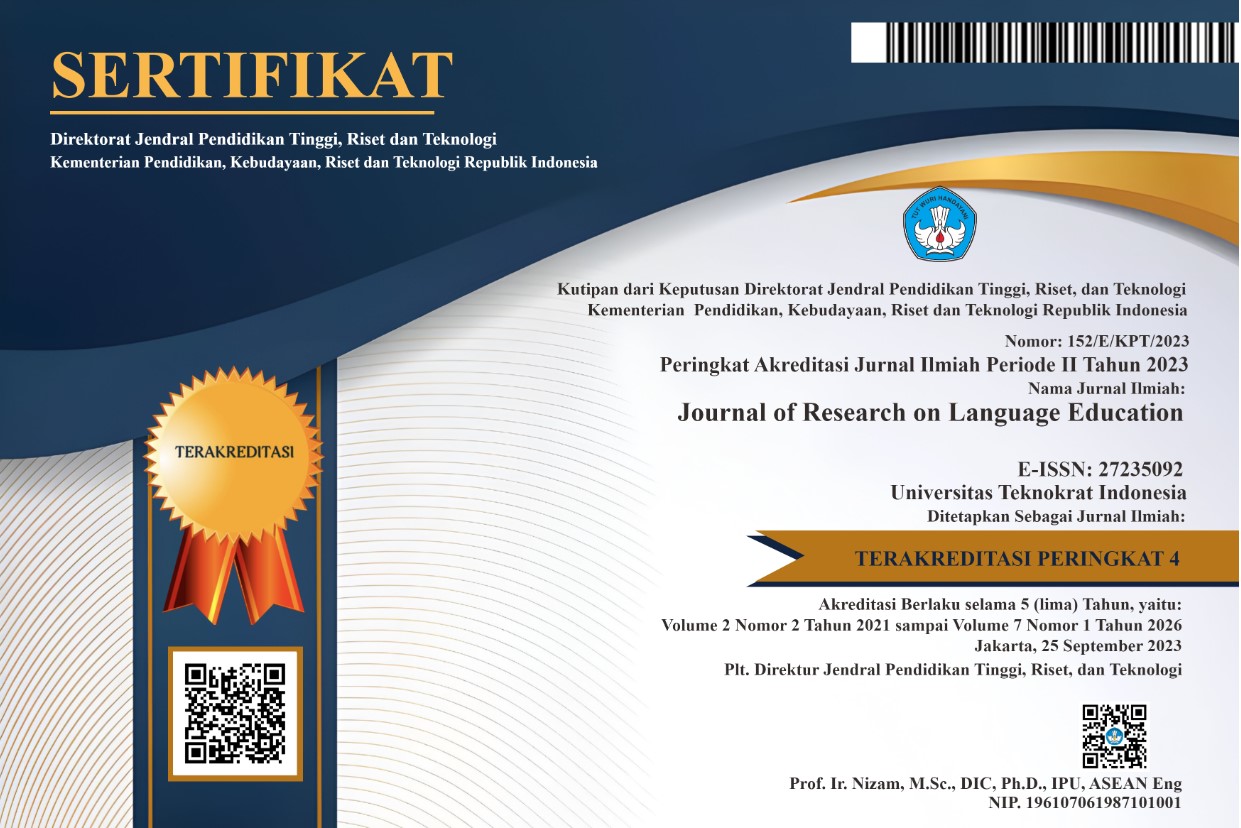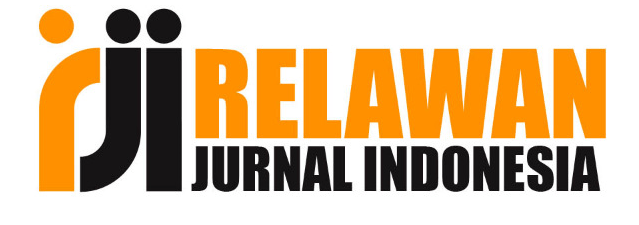A DEPTH INSPECTION ON INFORMAL SCHOOL STUDENTS’ DILEMMA IN TRANSLATING ENGLISH ARGUMENTATIVE TEXT TO INDONESIA
Abstract
The aim of this research is to analyse students' difficulties in translating argumentative text. It was conducted at FLC Course. The participant of this research consisted 15 students. The method of this research was descriptive qualitative. The instruments of this research were translation text and questionnaire sheet. The result of this study from translation text, students made mistake which were the ambiguity, sentence pattern, missing words, and non-linguistics factor. In questionnaire sheet, the highest score of students' difficulties was in linguistics factor which was about 55 score. It was difficulty in translating words which had double meaning. In non-linguistics factor, the highest score was 52 score. It was difficulty in translating words that related with ideology value. Besides, there are internal and external factors from within students that affect their difficulties where the internal factor is the students' motivation and interested in learning is lacking. While external factors are a lack of attention from the teacher and parent, inexact of methodologies in leaning and the lack of student facilities in learning. Based on the result above, it can be concluded that students' difficulties in translating argumentative text more dominant come from linguistics factor than non-linguistics factor.
Keywords
Full Text:
PDFReferences
Casanova, P., & Brownlie, S. (2021). Consecration and accumulation of literary capital: translation as unequal exchange. In The Translation Studies Reader (pp. 407–423). Routledge.
Ducar, C., & Schocket, D. H. (2018). Machine translation and the L2 classroom: Pedagogical solutions for making peace with Google translate. Foreign Language Annals, 51(4), 779–795.
Chen, J. C. (2017). Nontraditional adult learners: The neglected diversity in postsecondary education. Sage Open, 7(1), 2158244017697161.
Colina, S., Marrone, N., Ingram, M., & Sánchez, D. (2017). Translation quality assessment in health research: A functionalist alternative to back-translation. Evaluation & the Health Professions, 40(3), 267–293.
Kegan, R. (2018). What “form” transforms?: A constructive-developmental approach to transformative learning. In Contemporary Theories of Learning (pp. 29–45). Routledge.
Kaharuddin, A. (2018). The communicative grammar translation method: a practical method to teach communication skills of English. ETERNAL (English, Teaching, Learning, and Research Journal), 4(2), 232–254.
Lee, S.-M. (2020). The impact of using machine translation on EFL students’ writing. Computer Assisted Language Learning, 33(3), 157–175.
Liu, Z. (2020). A study on English translation of tourism publicity in coastal cities from the perspective of cross-cultural communication. Journal of Coastal Research, 115(SI), 87–89.
Robinson, D. (2019). Becoming a translator: An introduction to the theory and practice of translation. Routledge.
Malyuga, E., Krouglov, A. V, & Tomalin, B. (2018). Linguo-cultural competence as a cornerstone of translators’ performance in the domain of intercultural business communication. XLinguae, 11(2), 566–582.
Lefebure, C. (2019). Translating letters: Criticism as a perspective for a translator. Applied Translation, 13(1), 32–39.
Arono, A., & Nadrah, N. (2019). Student' difficulties in translating text. JOALL (Journal of Applied Linguistics and Literature), 4(1), 88–99.
Kathpalia, S. S., & See, E. K. (2016). Improving argumentation through student blogs. System, 58, 25–36.
Simanjuntak, M. B., Barus, I. R. G., & Resmayasari, I. (2021). Analysis of song" Tanganku Na Metmet" by using translation techniques into English. UICELL Conference Proceeding, 195–202.
Kalu, M. E. (2019). Using emphasis-purposeful sampling-phenomenon of interest–context (EPPiC) framework to reflect on two qualitative research designs and questions: A reflective process. The Qualitative Report, 24(10), 2524–2535.
Etikan, I., Musa, S. A., & Alkassim, R. S. (2016). Comparison of convenience sampling and purposive sampling. American Journal of Theoretical and Applied Statistics, 5(1), 1–4.
Rahadi, I., Nursaly, B. R., Handini, B. S., & Murcahyanto, H. (2021). Penguasaan Bahasa Inggris masyarakat dan partisipasinya dalam pengembangan desa wisata. JOEAI: Journal of Education and Instruction, 4(2), 486-494.
Hastuti, Y., Kardena, A., & Chio, E. (2020). Students' difficulties in translating narrative text from English to Indonesia at IAIN Bukittinggi. ETERNAL (English, Teaching, Learning, and Research Journal), 6(1), 135-148.
Jaelani, S. R., Handini, B. S., Prasetiyaningrum, A., Mursal, T. H., & Arafah, H. (2022). The correlation among grit, EFL learners’ motivation and applied linguistics on syntax for EFL learners. Pedagogy: Journal of English Language Teaching, 10(1), 76-84.
Rafsanjani, A. A. (2020, June). Errors analysis in Bahasa Indonesia to English translation in descriptive text made by Indonesian students. In International Conference on Science and Education and Technology (ISET 2019) (pp. 638-641). Atlantis Press.
Maximilian, A., & Scholar, I. P. D. (2020). Translation ability, reading habit, and reading skill in vocational school students in Indonesia: A correlation. JETA (Journal of English Teaching and Applied Linguistic), 1(1), 19-27.
Sriyono, S. (2018). Aspek Linguistik Dalam Penerjemahan. Prosodi, 12(2), 273-281.
Ulanska, T. (2015). The role of linguistic factor in translation. Procedia-Social and Behavioral Sciences, 191, 2585-2587.
Hadrus, M. S. (2017). The Analysis of Students Difficulties in Translating Argumentative Text from English to Indonesia at the Second Grade Students of SMA Negeri 1 Lappariaja Bone Regency. English Education Department the FAculty of Tarbiyah and Teaching Science UIN Alauddin Makassar, 3, 23-54.
Hariati, D. S. (2018). The Analysis of Students Difficulties in Translating Argumentative Text from English To Indonesian At the Second Grade Students of MAN Tebing Tinggi (Doctoral dissertation, Universitas Islam Negeri Sumatera Utara).
Noviyana, A., Saun, S., & Narius, D. (2018). Students’ ability in translating sentences in the recipe text from English to Bahasa Indonesia. Journal of English Language Teaching, 6(1), 354-361.
DOI: https://doi.org/10.33365/jorle.v4i1.2384
Refbacks
- There are currently no refbacks.

This work is licensed under a Creative Commons Attribution-NonCommercial-ShareAlike 4.0 International License.

Articles published in Journal of Research on Language Education is licensed
under a Creative Commons Attribution-ShareAlike 4.0 International License.
English Education Study Program, Faculty of Arts and Education.
Universitas Teknokrat Indonesia
Zainal Abidin Pagaralam 9-11 Bandar Lampung, Indonesia
All rights reserved.








